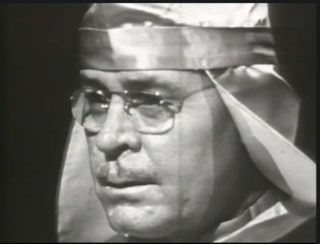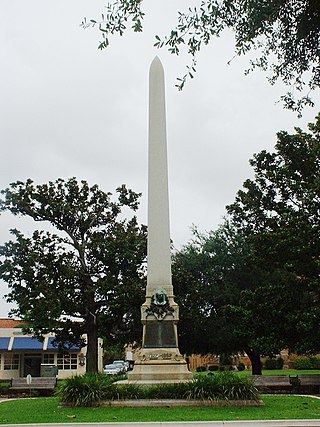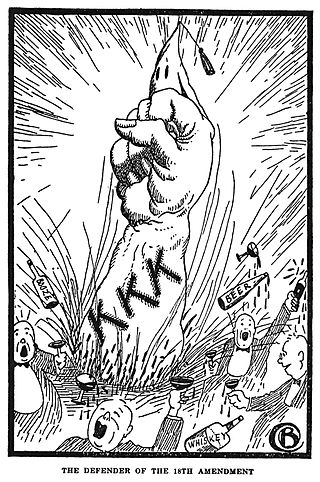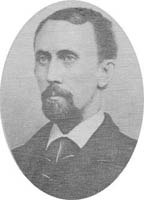
The Ku Klux Klan, commonly shortened to the KKK or the Klan, is the name of several historical and current American white supremacist, far-right terrorist organizations and hate groups. According to historian Fergus Bordewich, the Klan was "the first organized terror movement in American history." Their primary targets at various times have been African Americans, as well as Jews and Catholics.

Eldon Lee Edwards was an American Ku Klux Klan leader.
The grand wizard is the national leader of several different Ku Klux Klan organizations in the United States and abroad.

William Joseph Simmons was an American preacher and fraternal organizer who founded and led the second Ku Klux Klan from Thanksgiving evening 1915 until being ousted in 1922 by Hiram Wesley Evans.

William Dudley Chipley was an American railroad executive and politician who was instrumental in the building of the Pensacola and Atlantic Railroad and was a tireless promoter of Pensacola, his adopted city, where he was elected to one term as mayor, and later to a term as Florida state senator.
This is a partial list of notable historical figures in U.S. national politics who were members of the Ku Klux Klan before taking office. Membership of the Klan is secret. Political opponents sometimes allege that a person was a member of the Klan, or was supported at the polls by Klan members.
Ku Klux Klan auxiliaries are organized groups that supplement, but do not directly integrate with the Ku Klux Klan. These auxiliaries include: Women of the Ku Klux Klan, The Jr. Ku Klux Klan, The Tri-K Girls, the American Crusaders, The Royal Riders of the Red Robe, The Ku Klux balla, and the Klan's Colored Man auxiliary.

Attack on Terror: The FBI vs. the Ku Klux Klan is a 1975 American two-part made-for-television drama film which dramatizes the events following the 1964 abduction and murders of Chaney, Goodman, and Schwerner in Mississippi. In this, it is similar in theme to the 1988 movie Mississippi Burning, though some names and details were changed, and both productions pick up the approximate storyline of the 1990 TV-movie Murder in Mississippi.
The national leader of the Ku Klux Klan is called either a Grand Wizard or an Imperial Wizard, depending on which KKK organization is being described.

The White Knights of the Ku Klux Klan is a Ku Klux Klan (KKK) organization which is active in the United States. It originated in Mississippi and Louisiana in the early 1960s under the leadership of Samuel Bowers, its first Imperial Wizard. The White Knights of Mississippi were formed in December 1963, when they separated from the Original Knights of Mississippi after the resignation of Imperial Wizard Roy Davis. Roughly 200 members of the Original Knights of Louisiana also joined the White Knights. Within a year, their membership was up to around six thousand, and they had Klaverns in over half of the counties in Mississippi. By 1967, the number of active members had declined to around four hundred. Similar to the United Klans of America (UKA), the White Knights are very secretive about their group.

Arthur Hornbui Bell was an attorney and the Grand Dragon of the Ku Klux Klan in New Jersey.

The Indiana Klan was a branch of the Ku Klux Klan, a secret society in the United States that organized in 1915 to promote ideas of racial superiority and affect public affairs on issues of Prohibition, education, political corruption, and morality. It was strongly white supremacist against African Americans, Chinese Americans, and also Catholics and Jews, whose faiths were commonly associated with Irish, Italian, Balkan, and Slavic immigrants and their descendants. In Indiana, the Klan did not tend to practice overt violence but used intimidation in certain cases, whereas nationally the organization practiced illegal acts against minority ethnic and religious groups.

The Ku Klux Klan has had a history in the U.S. state of New Jersey since the early part of the 1920s. The Klan was active in the areas of Trenton and Camden and it also had a presence in several of the state's northern counties in the 1920s. It had the most members in Monmouth County, and operated a resort in Wall Township.
The New York World's exposé of the Ku Klux Klan brought national media to the operations and actions of the Ku Klux Klan beginning on September 6, 1921. The newspaper published a series of twenty one consecutive daily articles, edited by Herbert Bayard Swope, that discussed numerous aspects of Ku Klux Klan including rituals, recruitment methods, propaganda, and hypocrisies in logic. At least eighteen other newspapers nationwide picked up the coverage, which led to national discourse on the activities of the group. These publications included the St. Louis Post-Dispatch, Boston Globe, Pittsburgh Sun, The Plain Dealer (Cleveland), New Orleans Times-Picayune, Galveston News, Houston Chronicle, Seattle Times, Milwaukee Journal, Minneapolis Journal, Oklahoma City Oklahoman, Toledo Blade, Fort Wayne News-Sentinel, Syracuse Herald, Columbus Enquirer-Sun and the Albany Knickerbocker Press. The New York Times ran ads for the article series to increase exposure, while other large papers like the Baltimore Sun quickly picked up the article series instead of advertising for The World. The Ku Klux Klan announced shortly afterward that it would take legal action against all the publications that ran the article series for libel, seeking total damages of over $10 million. Following the exposé, Klan membership significantly increased.
The Knights of the Flaming Circle was a militant organization founded in 1923 to fight the anti-Catholic Ku Klux Klan. They were part of an opposition that included politicians, labor leaders and immigrant groups. Membership was open to anyone who opposed the KKK and was "not a Protestant". They had significant support amongst various ethnic groups in Pennsylvania and West Virginia. Bryce Bauer has written that, "Instead of only admitting white, native-born Protestants as the Klan did, the organization vowed to accept anyone who was anything other than that."

The Ku Klux Klan is an organization that expanded operations into Canada, based on the second Ku Klux Klan established in the United States in 1915. It operated as a fraternity, with chapters established in parts of Canada throughout the 1920s and early 1930s. The first registered provincial chapter was registered in Toronto in 1925 by two Americans and a Canadian. The organization was most successful in Saskatchewan, where it briefly influenced political activity and whose membership included a member of Parliament, Walter Davy Cowan.

Colonel Hiram C. Whitley was the second Chief of the United States Secret Service.

Nancy K. MacLean is an American historian. She is the William H. Chafe Professor of History and Public Policy at Duke University. MacLean's research focuses on race, gender, labor history and social movements in 20th-century U.S. history, with particular attention to the U.S. South.

Ron Stallworth is an American retired police officer who infiltrated the Ku Klux Klan in Colorado Springs, Colorado, in the late 1970s. He was the first African-American detective in the Colorado Springs Police Department.













